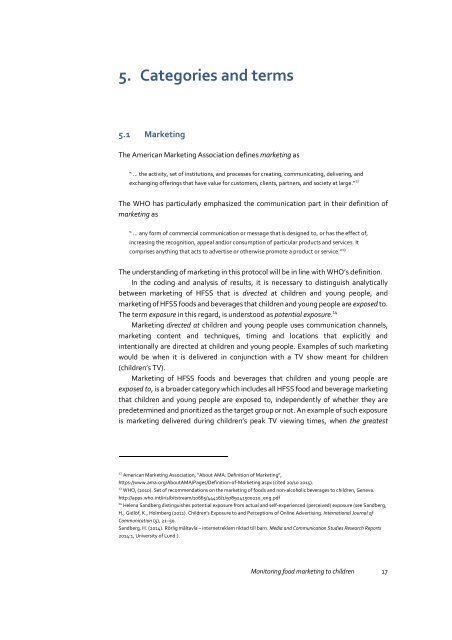TN2018504
Create successful ePaper yourself
Turn your PDF publications into a flip-book with our unique Google optimized e-Paper software.
5. Categories and terms<br />
5.1 Marketing<br />
The American Marketing Association defines marketing as<br />
“ … the activity, set of institutions, and processes for creating, communicating, delivering, and<br />
exchanging offerings that have value for customers, clients, partners, and society at large.” 12<br />
The WHO has particularly emphasized the communication part in their definition of<br />
marketing as<br />
“ … any form of commercial communication or message that is designed to, or has the effect of,<br />
increasing the recognition, appeal and/or consumption of particular products and services. It<br />
comprises anything that acts to advertise or otherwise promote a product or service.” 13<br />
The understanding of marketing in this protocol will be in line with WHO’s definition.<br />
In the coding and analysis of results, it is necessary to distinguish analytically<br />
between marketing of HFSS that is directed at children and young people, and<br />
marketing of HFSS foods and beverages that children and young people are exposed to.<br />
The term exposure in this regard, is understood as potential exposure. 14<br />
Marketing directed at children and young people uses communication channels,<br />
marketing content and techniques, timing and locations that explicitly and<br />
intentionally are directed at children and young people. Examples of such marketing<br />
would be when it is delivered in conjunction with a TV show meant for children<br />
(children’s TV).<br />
Marketing of HFSS foods and beverages that children and young people are<br />
exposed to, is a broader category which includes all HFSS food and beverage marketing<br />
that children and young people are exposed to, independently of whether they are<br />
predetermined and prioritized as the target group or not. An example of such exposure<br />
is marketing delivered during children’s peak TV viewing times, when the greatest<br />
12 American Marketing Association, “About AMA: Definition of Marketing”,<br />
https://www.ama.org/AboutAMA/Pages/Definition-of-Marketing.aspx (cited 20/10 2015).<br />
13 WHO, (2010). Set of recommendations on the marketing of foods and non-alcoholic beverages to children, Geneva.<br />
http://apps.who.int/iris/bitstream/10665/44416/1/9789241500210_eng.pdf<br />
14 Helena Sandberg distinguishes potential exposure from actual and self-experienced (perceived) exposure (see Sandberg,<br />
H., Gidlöf, K., Holmberg (2011). Children’s Exposure to and Perceptions of Online Advertising. International Journal of<br />
Communication (5), 21–50.<br />
Sandberg, H. (2014). Rörlig måltavla – internetreklam riktad till barn. Media and Communication Studies Research Reports<br />
2014:1, University of Lund.).<br />
Monitoring food marketing to children 17


